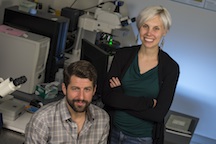Editor’s note: A link to an image for download appears at the end of this release.
David Ruth
713-348-6327
david@rice.edu
Mike Williams
713-348-6728
mikewilliams@rice.edu
Rice developing mobile DNA test for HIV
Diagnostic test aimed at detecting virus in infants, viral loads in older patients in low-resource settings
HOUSTON – (June 5, 2014) – Rice University bioengineers are developing a simple, highly accurate test to detect signs of HIV and its progress in patients in resource-poor settings.
The current gold standard to diagnose HIV in infants and to monitor viral load depends on lab equipment and technical expertise generally available only in clinics, said Rice bioengineer Rebecca Richards-Kortum. The new research features a nucleic acid-based test that can be performed at the site of care.
Richards-Kortum, director of the Rice 360˚: Institute for Global Health Technologies, and her colleagues reported their results in the American Chemical Society journal Analytical Chemistry.
The proof-of-concept work by co-lead authors Zachary Crannell and Brittany Rohrman, both graduate students in the Richards-Kortum lab, follows their similar technique to detect the parasite that causes the diarrheal disease cryptosporidiosis, reported earlier this year.
The new technique would replace a complex lab procedure based on polymerase chain reaction with one that relies on recombinase polymerase amplification (RPA), a method to quickly amplify – that is, multiply – genetic markers found in blood to levels where they can be easily counted. In a test the team calls qRPA, a specific sequence in HIV DNA is targeted and tagged with fluorescent probes that can be seen and quantified by a portable machine. Software analysis of the fluorescing DNA allows clinicians to determine with great accuracy whether the virus is present in a patient’s blood and/or how much is there.
The researchers calibrated the test by also amplifying an internal positive control not found in human blood. “It’s amplified by the same primers as the HIV sequence, so it tells us that the assay is working properly,” Rohrman said.
The students originally intended their work to look for HIV in infants, but the technique can also help to track viral loads in older patients. “It’s important for clinicians to be able to quantitatively monitor patients’ viral loads in order to ensure the disease is responding to therapy,” Crannell said.
To be clinically viable, a DNA-based test for HIV has to be able to quantify virus loads over four orders of magnitude, from very low to very high, the researchers said. They reported the Rice test easily meets that goal.
They are developing tools for low-resource settings where high-tech lab equipment is not available. Although they used a thermal cycler, the researchers are working on a technique that will keep the entire procedure between room and body temperatures so that it can be performed at the point of care in the developing world.
The research was funded by a grant from the Bill & Melinda Gates Foundation through the Grand Challenges in Global Health Initiative.
-30-
Read the abstract at http://pubs.acs.org/doi/abs/10.1021/ac5011298
Follow Rice News and Media Relations via Twitter @RiceUNews
Related Materials:
Rice 360˚: Institute for Global Health Technologies: http://www.rice360.rice.edu
BioScience Research Collaborative: http://brc.rice.edu/home/
Image for download:
https://news2.rice.edu/files/2014/06/0609_HIV-1-WEB.jpg
Rice graduate students Zachary Crannell, left, and Brittany Rohrman are leading Rice University bioengineers in an effort to develop an efficient test to detect signs of HIV and its progress in patients in low-resource settings. (Credit: Jeff Fitlow/Rice University)
Located on a 300-acre forested campus in Houston, Rice University is consistently ranked among the nation’s top 20 universities by U.S. News & World Report. Rice has highly respected schools of Architecture, Business, Continuing Studies, Engineering, Humanities, Music, Natural Sciences and Social Sciences and is home to the Baker Institute for Public Policy. With 3,920 undergraduates and 2,567 graduate students, Rice’s undergraduate student-to-faculty ratio is 6.3-to-1. Its residential college system builds close-knit communities and lifelong friendships, just one reason why Rice has been ranked No. 1 for best quality of life multiple times by the Princeton Review and No. 2 for “best value” among private universities by Kiplinger’s Personal Finance. To read “What they’re saying about Rice,” go here.


